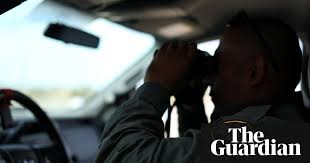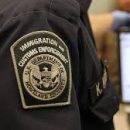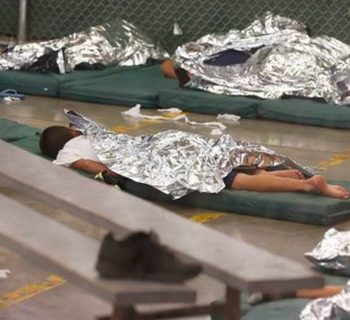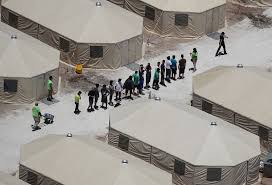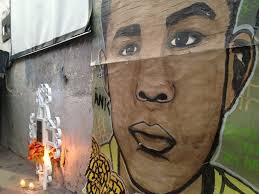By Sarah Macaraeg ~ The Guardian ~ May 1, 2018
Exclusive: analysis of more than a decade of official data reveals government paid settlements after deaths, alleged assaults and wrongful detention.
The US government has paid out more than $60m in legal settlements where border agents were involved in deaths, driving injuries, alleged assaults and wrongful detention, an analysis of more than a decade of official data reveals.
Since taking office, Donald Trump has been pushing to expand the patrol force at the southern border, insisting recently on Twitter: “Border Patrol Agents are not allowed to properly do their job at the Border because of ridiculous liberal (Democrat) laws.”
But while Trump has ordered national guard troops to be deployed to provide agents with extra support, the review of settlement data and details found in related court records raises concerns about the agency’s history of interactions with civilians, both native-born and immigrant.
Cases uncovered by examination of treasury payment records spanning October 2005 to July 2017, court documents and media reports reveal:
- The federal government has settled at least 20 wrongful death claims on behalf of CBP, paying more than $9m to the families of people killed since 2003, in incidents including shooting, beating, use of Tasers and collisions with vehicles.
- Nearly $47m has been paid out for damages resulting from alleged reckless driving by border agents. Of more than 1,300 such payments, made in states across the country, a review of 40 cases with available court records found six crashes which were deadly and 18 that cited grave injuries including amputations and disability.
- Four people, including two US citizens and a legal permanent resident received settlements for being wrongly deported. Nine people, including three citizens, two immigrants with legal status and two tourists, received settlements for illegal detentions of between four days and two months;
- More than $650,000 was paid out in settlements in four cases where four people were shot by border agents and survived.
The data also reveals another $6m in settlements stemming from a range of other allegations involving non-deadly force and civil rights violations. Lawsuits were filed by men and women who say they were racially profiled, unreasonably searched, detained for hours on end and in some cases assaulted.
Some describe having guns held to their heads; others alleged they were beaten at checkpoints, land crossings, in the rural desert, at an airport, in front of their children, or, in one instance, in their own home.
The Guardian analysis comes after border agent Lonnie Swartz was last month cleared on a murder charge in connection with the death of 16-year-old José Antonio Elena Rodríguez who died after Swartz fired 16 times across the border from Arizona into Mexico.

According to the American Civil Liberties Union’s Chris Rickerd, who monitors CBP nationally, the settlements hint at larger patterns of misconduct that go unchallenged. “There’s a whole web of things that make this a particularly hard road,” said Rickerd, citing fear among border communities whose livelihoods often rely on crossing checkpoints.
He also noted the border patrol’s refusal to adopt the use of body cameras as a barrier to evidence gathering; and a federal claims process which relies on a person’s willingness to take the US government to court, after first being ignored or rejected by the agency.
Although Trump has been frustrated that Congress rejected funding for 5,000 more border agents, the border patrol is already the largest and most funded federal law enforcement agency.
It is part of the umbrella agency US Customs and Border Protection (CBP), which has approximately 60,000 employees split in four major divisions: officers who inspect imports; an air and marine division; agents who staff ports of entry – international airports, seaports and land crossings – and the approximately 20,000 agents of the border patrol, who are concentrated in the south-west but stationed nationwide.
The border patrol enjoys extraordinary police powers. Agents operate checkpoints where they stop motorists every day without suspicion, and in the interior of the country up to 100 miles, they can board planes, trains and buses. There is no geographic limit to which agents can otherwise conduct stops amid roving patrols, though they are technically required to have reasonable suspicion to do so.
Extending from not only land borders but also the Pacific, Atlantic, Gulf and Great Lakes coasts, the 100-mile zone encompasses two out of every three Americans, 12 states in their whole or near entirety and nine of the 10 biggest cities in the nation.
Rickerd of the ACLU added: “Courts are slamming the door, not even on amounts, but in making the claim and getting it heard,” in a spate of cross-border shooting deaths that took place on Mexican soil. The parents of Sergio Adrián Hernández Güereca have fought for their right to file a wrongful death suit against the federal government all the way up to the supreme court, which sent the question of whether constitutional rights extend past the border to a lower court, where the case was dismissed in March 2018.

As for events occurring inside the US, he said: “Even in some cases of the most obvious harms, when a policy has been breached and there’s been deep injury, where in the municipal context you’d see large awards, because of the amount of suffering or extent of misconduct,” he said, “in the border patrol context, it’s very rare.”
All told over the 12-year period studied, the treasury department cut a check to settle a claim against CBP every 32 hours on average, for a grand total of more than $177m, when $116m in claims related to employment or property are taken into account.
However, while the data studied by the Guardian is extensive, it still does not give a full picture of all settlements. Provided by the US treasury department, the data only represents payments made from the federal government’s Judgement Fund, which pays out when an agency does not have funds available to compensate a claim for damages.
The Department of Homeland Security, CBP’s parent agency, did not respond to requests for comment on any additional payments it has made directly.
When asked whether civil complaints give rise to internal reviews, a CBP spokesperson said they do not, because the agency would already have reviewed any incident involving injury or death, according to policy.
The agency’s Use of Force Review Board has investigated 30 significant incidents since June 2015. Each of its 17 reports made public have considered the use of force compliant with agency policy.
The Department of Homeland Security’s office of inspector general said that only in very rare instances of matters of significant public interest and importance will the office review any issue related to civil litigation.
- This story is a collaboration with the CJ Project. Reporter Sarah Macaraeg can be contacted at sarah.macaraeg@gmail.com
- Sign up to get the day’s top US stories delivered straight to your inbox every morning
Source: Sarah Macaraeg ~ The Guardian

